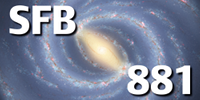Subproject P02: Asteroseismic stellar parameters of open cluster stars
Saskia Hekker (HITS/LSW)
Open clusters are prominent features in our Milky Way system. In open clusters, stars form at approximately the same time in a relatively confined space. Therefore, stars in open clusters are assumed to have the same age and metallicity. These additional constraints make open clusters important landmarks in our Milky Way. At these landmarks we can determine cluster and stellar parameters with high fidelity compared to field stars. Additionally, we will be able to probe stars with known ages and metallicities at different points in evolution to test our understanding of stellar evolution. Finally, with time the cluster will dissolve, and the stars will spread out and become field stars. So, studying stars in open clusters will provide us with valuable information on the conditions of star formation of the next generation of field stars in our Galaxy. In this proposal we intend to use asteroseismology – the study of the internal structure of stars through their global oscillation modes – to obtain accurate masses, radii, ages and distances, as well as cluster membership of individual cluster stars and with that improve the determined age and distance of the cluster as seen as one entity. In this study we will focus on red-giant stars as these stars are intrinsically bright and cover a large range of parameters in terms of mass, age and distance, which makes them excellent candidates for galactic archaeology. Additionally, these stars show oscillations with relatively large amplitudes. For this study we will use timeseries data from the Kepler, K2 and TESS space missions in combination with Gaia astrometry (parallaxes and proper motions), publicly available spectroscopic data (in particular effective temperatures and metallicities) from SDSS-IV and proprietary SDSS-V data, as well as photometry from for instance the 2MASS and AllWISE catalogues as well as dedicated photometric cluster catalogues such as R1 and R2. Depending on the available data, we take two different avenues in this proposal. In one avenue we will perform an in-depth study of a few open clusters using individual stellar oscillations of red-giant cluster members as observed by the Kepler mission. In another avenue we will investigate many more open clusters for their physical properties using global asteroseismic parameters of the red giants. The latter cluster targets will be the ones observed by the K2 and TESS missions. With these two avenues we aim to derive the most accurate and precise masses, ages and distances of many open clusters using asteroseismic constraints in addition to photometric, spectroscopic and astrometric constraints. While at the same time for a subsample of stars we aim to 1) improve the precision and accuracy of these parameters further by using individual frequencies and 2) determine the present-day helium abundances of the stars. The latter will provide important constraints on our knowledge of the primordial helium abundance of the environment in which these stars were formed. So, in this proposed study, we will obtain ages and distances for a number of open clusters for which asteroseismic data are available. Thanks to the additional asteroseismic constraints these parameters can be determined with unprecedented accuracy and precision. Hence, enhancing our knowledge of important landmarks in our Milky Way. Additionally, this study will probe stars with known ages and metallicities at different points in evolution, which will allow for testing current state-of-the-art stellar evolution models. For open clusters containing red giants in different evolutionary states, i.e., hydrogen-shell burning or core-helium burning stars, we will be able to investigate possible age spreads between the stars within a cluster as well as possible mass loss occurring on the red-giant branch


